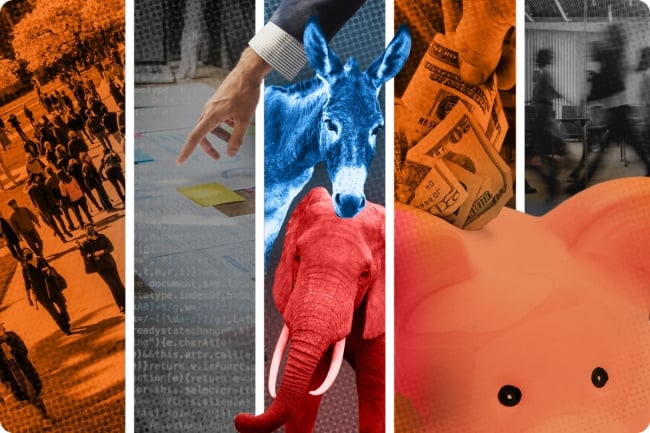You have /5 articles left.
Sign up for a free account or log in.

State higher education executives discussed declining enrollment, financial woes and workforce demands as key areas of focus for public colleges and universities.
Photo illustration by Justin Morrison/Inside Higher Ed | gmc3101, LeonidKos/iStock/Getty Images | Markus Spiske/Rawpixel
WASHINGTON—Hundreds of state higher education officials, policymakers and researchers came together in the nation’s capital this week to share data, discuss system-level solutions and lament the struggles of a sector susceptible to political polarization and riddled with fragile finances.
Celebrating the 70th anniversary of its annual conference, the State Higher Education Executive Officers Association reflected on the history of higher education oversight but also looked forward, recognizing a paradigm shift in the way institutions operate and serve their students. Over the course of four days, attendees discussed enrollment trends, equity and access initiatives, workforce demands, artificial intelligence, the future of funding, and more.
Here is a look at three thematic threads that emerged from this year’s summit.
Navigating a New Reality
Nathan Grawe, a professor of economics at Carleton College, on Tuesday presented sobering statistics modeling enrollment trends for public and private institutions for the next 25 years.
America’s birth rate declined by an average of 2 percent from 2015 to 2020. It hit an all-time low in 2023, with only about 3.6 million babies born, according to an April report from the National Center for Health Statistics. And while there will be an 18-year-delay before that drop hits higher ed enrollments, the decline in births began as early as 2007. The babies born that year will be stepping on campus as soon as fall 2025, and class sizes of traditional students will only continue to shrink from there.
“We really are coming out of the golden age for higher education, from World War II until 2010,” Grawe said. “But since 2010, we’ve been in an age of reversal rather than growth.”
And although the matriculation rate has also declined in recent years, boosting the percentage of high school students who pursue higher education isn’t going to be enough to fill the empty seats.
“In the short run, we would need to see a matriculation rate rise from about 62 percent currently to something like 75 percent” to make up for the demographic cliff, Grawe explained. Even then, that would only maintain the current enrollment rates, not lift them to where they were at their peak. “I’m not saying matriculation can’t be part of the solution,” he said. “But when I look at this, I would say that if that is the only solution we have in mind, we are probably going to fail.”
Grawe suggested it will take a comprehensive approach—including campus consolidations, new recruitment strategies such as direct admissions and targeting nontraditional adult learners and racially underrepresented groups—to solve higher education’s enrollment problem.
But in an era when public perceptions of higher ed are less than sanguine, and conservative lawmakers have branded colleges and universities as bastions of liberal elitism, prioritizing access comes with its own challenges.
Riding on the momentum of the Supreme Court ruling that declared the consideration of race in college admissions unconstitutional, Republican lawmakers across the country have introduced, and in some cases passed, a gamut of anti–diversity, equity and inclusion legislation. The political headwinds facing DEI initiatives have left many college administrators and state officials cautious to continue or expand any equity work for fear of losing state funds or prompting even more stringent restrictions.
But three state officers, from Idaho, Iowa and Utah, spoke about their efforts to maintain diverse, equitable and inclusive campuses even in the midst of the culture wars in their Republican-led states.
Geoffrey Landward, commissioner of the Utah System of Higher Education, advised his colleagues to engage skeptical lawmakers early on in the legislative process.
The question is “How did we get from bad to workable?” he said. “The bills that I’ll talk about today, they passed in a good, workable place, a place that addressed [conservative lawmakers’] concerns but also didn’t burn down the whole house. But they didn’t start that way.”
Landward’s co-panelists agreed, noting that the key is building trust and rapport, showing lawmakers that higher ed is not the enemy.
“We need to move the conversation to what are the outcomes we’re trying to achieve?” TJ Bliss, chief academic officer of the Idaho State Board of Education, said, suggesting higher ed leaders frame the conversation around topics like access and affordability, workforce development, and belonging. “When we get there … we have a lot more common ground.”
Being Frank About Finances
The conference was also laden with candid, often dispiriting, conversations about the financial future of public colleges and universities in an increasingly oversaturated market, especially in the Midwest and Northeast, where there are more seats than students. For many, it’s clear the sector has an urgent need to wake up and respond.
“Everybody has the same data,” Dan Greenstein, outgoing chancellor of the Pennsylvania State System of Higher Education said at a closing panel, referring to the demographic cliff that Grawe mentioned earlier in the event. “The problem isn’t the lack of data. The problem is nobody’s got the political will to actually use it and make a difficult decision.”
And Greenstein understands why. During his tenure in Pennsylvania, one of the states most afflicted with oversaturation, he led the consolidation of six PASSHE institutions into two. It was no easy task, he said, acknowledging that closures would be even harder, but both will become increasingly necessary as “too many institutions go after the same kind of student.”
“I’d like to see the conversation flip to, what does a graceful exit look like?” he said.
Several panels touched on how state-level boards and agencies, be they governing or coordinating, can build stronger measures to safeguard the fiscal health of institutions.
Brian Bridges, secretary of higher education for New Jersey, said his state has recently introduced policies for assessing both the quality of program outcomes and the warning signs of closure. But “unfortunately” it took two institutions publicly announcing they were in dire straits, and an article in The Wall Street Journal, to spur a legislative response, he said. “We don’t often take these kinds of proactive actions until we have a crisis to respond to.”
Massachusetts passed a similar policy, the Fiscal Harm, Financial Assessment and Risk Monitoring Bill, in 2019, to mitigate the impacts of closures on students, their families, faculty and staff. Noe Ortega, the commonwealth’s commissioner of higher education, said the law will become increasingly important as the commission oversees small, private liberal arts institutions.
Murmurs of a possible economic recession are building, Ortega said. “People often feel that when there is a recession, people return to college. That may not be the case anymore … It’s very important that we go back and really re-examine what it means to be financially viable in the 21st century.”
Wrangling a Workforce
In the meantime, one of the ways state higher education officials are working to boost their finances is by homing in on workforce development and graduate outcomes. For many states that means expanding the offering of short-term, noncredit programs.
This is especially true as short-term Pell Grants, or federal aid for workforce training programs, has been reintroduced in Congress through the Bipartisan Workforce Pell Act. Although the legislation is currently stalled on the House floor, its passage out of committee in December has triggered state officials to work ahead and prepare for possible implementation.
Leaders representing systems from coast to coast discussed the ways they are working to collect data on all non-credit-bearing courses, including certificates, microcredentials and badges, that are offered by two- and four-year institutions. Some are aiming to build a registry to track these noncredit credentials as well as the return on investment they provide.
“We’re starting to understand the importance and need for this for financial aid” and the Integrated Postsecondary Education Data System, said Chris Tingle, assistant vice chancellor for data strategy at the Tennessee Board of Regents. “We’re starting from scratch on gathering noncredit data. It’s exciting and overwhelming.”
Lee Rector, associate commissioner for workforce education at the Texas Higher Education Coordinating Board, believes it’s the responsibility of state colleges to be nimble and provide training programs that respond to the labor-market needs of their region.
But some education leaders are skeptical, questioning the quality and value of such programs and expressing concerns about equity and perceived return on investment.
“We can’t disregard key entry-level jobs that are a first step to occupational mobility but don’t have high salaries,“ Rector said.
“If microcredentials aren’t valued by employers, we’re doing a disservice to minoritized students,” said Jesse Mason, associate vice chancellor of academic affairs for the Minnesota State Colleges and Universities.
For systems that are already underresourced, the task of cataloging all non-credit-bearing qualifications can be immense.
After the Texas state Legislature passed an outcomes-based funding model for its community colleges, David Troutman, deputy commissioner at the Texas Higher Education Coordinating Board, began auditing all nondegree credits to understand the investment students and institutions are making in them, from tracking student-staff contact hours to the cost of textbooks.
“The struggle is real,” he said. “It feels like I’m in a dark room and I’m trying to untangle a complicated knot.”
But conference attendees generally agreed that the hard work—in workforce development, legislative negotiations, tough conversations about financial sustainability and more—will be worth it.
“I don’t think it’s realistic to hope that we look back at this time period and say that was a grand time for higher ed,” Grawe, of Carlton, said. “But what if instead we look back and say we’ve expanded access, made policy changes to support students better, made clear connections between academe and life after college … If we did, I think we would look back and say it might not have been an easy time, but it was quite rewarding.”








